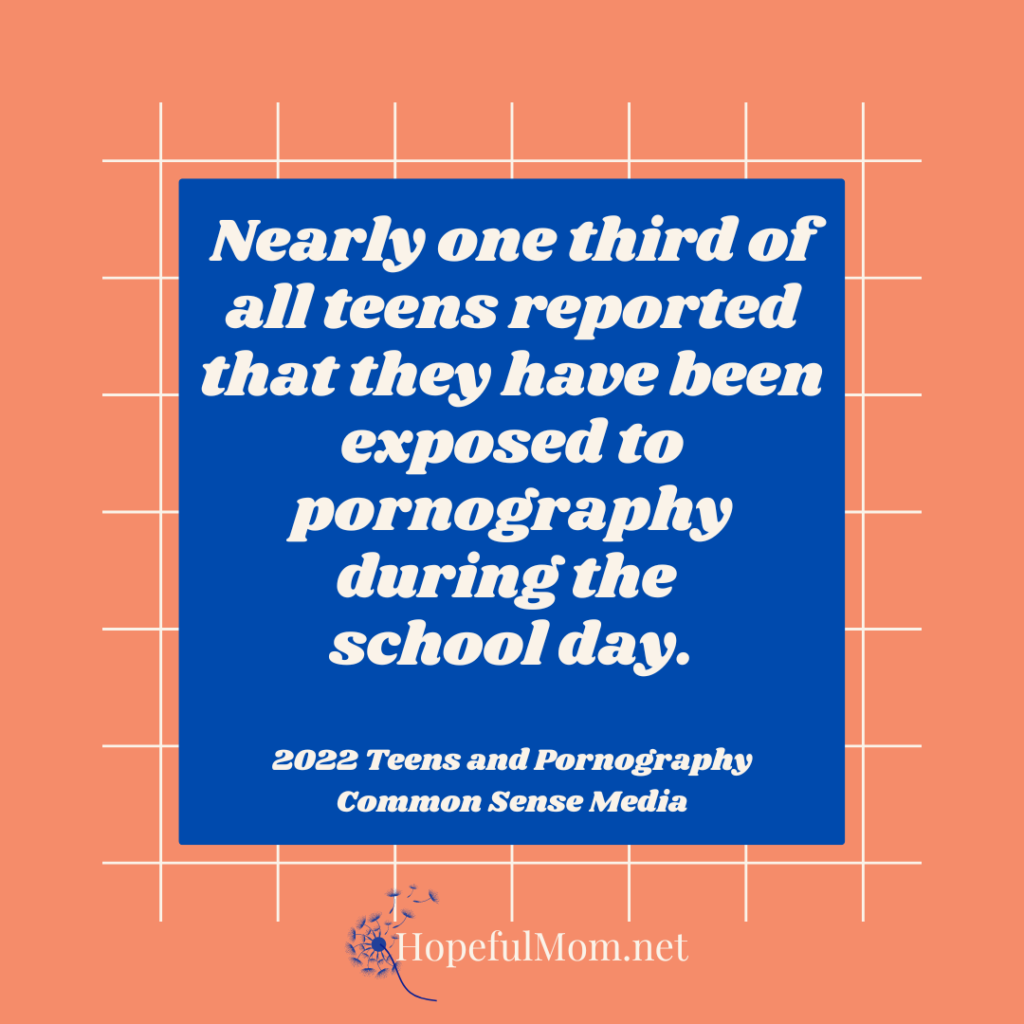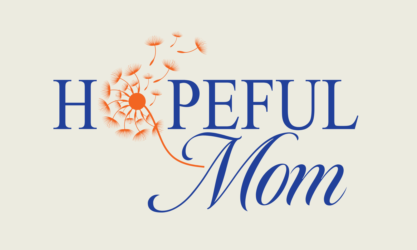When I learned my son was watching pornography I had a difficult time reconciling how this could have happened in my home. As I’ve mentioned in other posts, we were a home-schooling family who taught right from wrong to our children. I assumed my children would make good choices as they matured.
Reading pornography statistics helped me deal with my emotions and what I perceived as inept parenting. Our situation wasn’t an anomaly; rather, it was common. When I learned how prevalent this behavior was, I managed to step outside myself and view this issue from a societal standpoint. Pornography is a public concern.
Last month, Common Sense Media released a report entitled 2022 Teens and Pornography. The 27-page report is a compilation and summary of a survey conducted with 1358 teens age 13 to 17.
I’d like to outline some of their findings here in hopes that understanding these pornography statistics helps you parent your children better. I can’t possibly hit every point or stat in the report, so I recommend reading the full report yourself.
Before listing specific stats, I think it’s important to understand the purpose of the report and Common Sense Media’s definition of pornography.
“The purpose of the report is to understand the role that online pornography plays in U.S. adolescent life and to establish a baseline for understanding U.S. teens’ pornography use. For this report, online pornography includes any videos or photos viewed on websites, social media, or anywhere else on the internet that show nudity and sexual acts intended to entertain and sexually arouse the viewer. Pornography often features explicit pictures of body parts (such as the genitals) and sexual acts (including oral sex, masturbation, anal sex, etc.).” (All quotes in this post are from the Teens and Pornography report.)

10 Key Findings
The Common Sense Media report lists the following key findings from the survey.
- “Most teens (73%) reported that they have consumed pornography.” The average age of first exposure was 12, with 15% saying they had first seen porn at age 10 or younger.
- “Just under half of all teens (44%) indicated that they had done so intentionally, while slightly more than half (58%) indicated they had encountered pornography accidentally.” 29% reported both intentional and accidental viewing.
- Of those reporting accidental exposure, 63% indicated they had been exposed in the past week, “which could indicate that unintentional pornography exposure was a common experience for respondents.”
- Reported rates of exposure were similar across demographics, but there was a “significant difference by gender in terms of intentional consumption.”
- “Rates of intentional pornography consumption were also higher among respondents who are LGBTQ+ (66%), including transgender and nonbinary respondents (66%).”
- “There was tension between respondents’ enjoyment of pornography and their feelings of guilt associated with consuming it.” Most felt “OK” about the amount of pornography they watched, but “half reported feeling guilty or ashamed after watching.”
- “Teens indicated that they were learning about sex from the pornography they consume.”
- “A majority of teens who indicated they have viewed pornography have been exposed to aggressive and/or violent forms of pornography.”
- “Exposure to racial and ethnic stereotypes in pornography was also common.”
- Most teens have discussed sex-related issues with trusted adults, “but less than half (43%) have discussed pornography.”
Other Notable Findings
“Nearly one third of all teens reported that they have been exposed to pornography during the school day.” Among all teens surveyed, 23% had seen porn in person at school and 12% while attending school remotely. Of those who had watched pornography in person at school, 41% attended a private/religious school, 20% a traditional public school, 31% a charter/magnet school, and 11% were home schooled. While there is a difference in the number of children exposed depending on their school type, we should note that all children are at risk of being exposed during the school day.

“Of the teens who reported in this survey that they have deliberately viewed pornography, 59% indicated that they intentionally consumed pornography every week (not just in the previous seven days).” Of these, 38% viewed it through social media.
Trusted Adults
Because of my interactions with parents, caregivers, and leaders, I was most interested in the portion of the report about trusted adults. In the list of places where teens had learned about sex, the highest-ranking category was a parent, caregiver, or trusted adult (47%), followed by friends (41%), sex education in school (32%), and then online pornography (27%). When teens were asked about topics discussed with a parent, guardian, or trusted adult, relationships came out on top (82%). Porn was the topic least discussed (43%) with sex, condoms, and birth control ranking between these two topics.
"Many teens wish to have conversations with a trusted adult" about pornography, according to the new 2022 Teens and Pornography report by Common Sense Media #fightthenewdrug Recent Pornography Statistics: Why They Are Important Share on XMost teens in the survey reported positive outcomes resulting from their conversations with a trusted adult about pornography.
Many teens wish to have conversations with a trusted adult but don’t know how to initiate the conversation or said they didn’t know who to talk to.

Now What?
The good news is that we can and do influence our teens, and they want to hear from us. While these pornography statistics could be depressing, we can be encouraged by the fact that we now have more information and are better equipped to talk with our children.
We cannot ignore these pornography statistics. The time to act is now. If you haven’t broached this topic with your children, do so. If you’ve had conversations but they’ve been awkward or seemingly unproductive, that’s okay. Try again. If you need help getting started, read through past blog posts on this site or use books from the resources page. You can do it!
Be sure to subscribe using the form below. And follow Hopeful Mom on Facebook, Instagram, and LinkedIn. And check out Sexpectations: Helping the Next Generation Navigate Healthy Relationships.
About the author
Barb Winters is the author of Sexpectations: Helping the Next Generation Navigate Healthy Relationships and founder of Hopeful Mom. She’s a certified mental health coach and offers one-on-one consultations for parents. For more about Barb, click "About" in the menu.




Barb, Thank you so much for your article. This is a huge challenge in how we talk with our kids about pornography. I am the director of Adults Saving kids. See http://www.adultssavingkids.org It is so important that parents have good conversations with their children so they do not end up letting the pornographers getting control of their lives and their futures.
Alvin,
Thanks for reading and commenting. Yes, ongoing conversations is so important. Thanks for what you are doing to educate parents and grandparents. When we are educated, we can talk more openly with our children and encourage them better about healthy relationships.
it is good to know there are moms out there trying to fight the effects of pornography on young children/ adolescence. Even though my 16-year-old son is on his third Christian therapist, one change because we moved, he is not getting the help he needs for what he feels is a very strong addiction. addiction. All the celebrate recovery, 12-step sex addiction, even online programs you have to be 18 or older. I find that I’ve talked to my son and my husband does also, and he does have once a week therapy, but he needs an ongoing support group and I don’t know of any as I do research. I believe the amount of boys that view pornography at 10 years or less for the first time is much higher, because those are statistics based on I would think people that are being asked. looking for more help but certainly glad to find your website
Kelly Ann,
Thanks so much for reading and commenting.
I’m so sorry that pornography found your son and he’s struggling with an addiction. I’m grateful he has attentive parents who he can talk with and who are doing their best to help him. Good job. The fight is long and can get tiring, but it’s worth it.
When I was at a conference recently, I met Blake Brinkman of 423 Communities. I believe he and his team may be of help. You can look at the website here: https://www.423next.org/.
I think you are right about the age being younger. It’s certainly a difficult statistic to capture.
Please feel free to contact me directly through my contact page if you have any more thoughts or questions. Barb